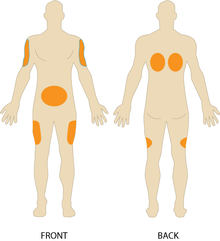Subcutaneous injection
A subcutaneous injection is administered as a bolus into the subcutis,[1] the layer of skin directly below the dermis and epidermis, collectively referred to as the cutis. Subcutaneous injections are highly effective in administering medications such as insulin, morphine, diacetylmorphine and goserelin. Subcutaneous (as opposed to intravenous) injection of recreational drugs is referred to as "skin popping." Subcutaneous administration may be abbreviated as SC, SQ, sub-cu, sub-Q, SubQ, or subcut. Subcut is the preferred abbreviation for patient safety.[2]
Subcutaneous tissue has few blood vessels and so drugs injected here are for slow, sustained rates of absorption.[3] It is slower than intramuscular injections but still faster than intradermal injections.[3]
Injection sites

Sites include,[3]
- The outer area of the upper arm.
- The abdomen, from the rib margin to the iliac crest and avoiding a 2-inch circle around the navel. This has the fastest rate of absorption among the sites.
- The front of the thigh, midway to the outer side, 4 inches below the top of the thigh to 4 inches above the knee. This has a slower rate of absorption than the upper arm.
- The upper back.
- The upper area of the buttock, just behind the hip bone. This has the slowest rate of absorption among the sites.
Equipment
A 25 to 31 gauge thick, 3/8" to 1" long needle can be used. The size is determined by the amount of subcutaneous tissue present, which is based on patient build. The 3/8" and 5/8" needles are most commonly used. Usually, no more than 1 mL of solution is given, compared to intradermal injections, where no more than 0.5 mL is usually given.[3]
Procedure
Subcutaneous injections are inserted at 45 to 90 degree angles, depending on amount of subcutaneous tissue present and length of needle- a shorter, 3/8" needle is usually inserted 90 degrees and a 5/8" needle is usually inserted at 45 degrees. Medication is administered slowly, about 10 seconds/milliliter.[3]
Subcutaneous insulin injections in diabetes mellitus

A person with insulin-dependent (either type 1 or type 2) diabetes mellitus typically injects insulin subcutaneously.[4]
The injection should be given under the skin, into the fat layer.
See also
- Intramuscular injection
- Intravenous injection
- Intradermal injection
References
- "subcutaneous injection" at Dorland's Medical Dictionary
- "ISMP's List of Error-Prone Abbreviations, Symbols,and Dose Designations" (PDF). www.ismp.org. 2013. Retrieved 13 May 2013.
- Taylor, C. R., Lillis, C., LeMone, P., Lynn, P. (2011) Fundamentals of nursing: The art and science of nursing care. Philadelphia: Lippincott Williams & Wilkins, page 749.
- "Insulin Administration". Diabetes Care. 25 (suppl 1): s112–s115. January 2002. doi:10.2337/diacare.25.2007.s112.
-solution.jpg)

